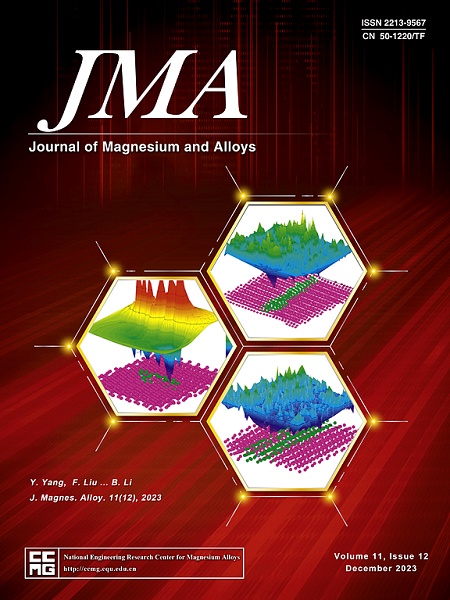Corrosion resistance of a calcium carbonate coating prepared by ultrasound-assisted chemical conversion in calcium disodium edetate solution
IF 15.8
1区 材料科学
Q1 METALLURGY & METALLURGICAL ENGINEERING
引用次数: 0
Abstract
A CaCO3 coating with good anticorrosion and adhesion performance was fabricated via ultrasound-assisted chemical conversion on AZ41 magnesium alloy, with a water-bath treated coating as a control. The coating formed on AZ41 mainly consists of an outer CaCO3 layer and an inner (Ca, Mg)CO3 layer. Surface characterizations were carried out to obtain the morphology and the chemical composition, mechanical tests were also adopted to assess the hardness and the adhesion of the coating prepared. Afterwards, the long-term corrosion resistance was investigated via electrochemical methods in the chloride-containing Portland cement system. Results show that the ultrasound-assisted coating exhibits higher mechanical properties. In addition, the corrosion resistance of the ultrasound-assisted coating is also higher than that of the bare AZ41 alloy and the water-bath treated coating. This could be due to the formation of a much more compact CaCO3 coating on AZ41 Mg alloy, which is mainly benefit from the assistance of the ultrasound. Ultrasound accelerates the nucleation of CaCO3 crystals and assists the removal of hydrogen bubbles. Additionally, corrosion mechanism was suggested and discussed for the CaCO3 coating.
超声辅助化学转化法制备的碳酸钙涂层在乙二胺四乙酸钙溶液中的耐蚀性
采用超声辅助化学转化的方法,在AZ41镁合金表面制备了具有良好防腐和粘附性能的CaCO3涂层,并用水浴处理的涂层作为对照。在AZ41上形成的涂层主要由外CaCO3层和内(Ca, Mg)CO3层组成。通过表面表征获得涂层的形貌和化学成分,并通过力学测试评估涂层的硬度和附着力。然后,通过电化学方法研究了含氯硅酸盐水泥体系的长期耐蚀性。结果表明,超声辅助涂层具有较高的力学性能。此外,超声辅助涂层的耐蚀性也高于裸AZ41合金和水浴处理涂层。这可能是由于在AZ41镁合金上形成了更致密的CaCO3涂层,这主要得益于超声波的帮助。超声波加速CaCO3晶体的成核,并帮助去除氢泡。并对CaCO3涂层的腐蚀机理进行了讨论。
本文章由计算机程序翻译,如有差异,请以英文原文为准。
求助全文
约1分钟内获得全文
求助全文
来源期刊

Journal of Magnesium and Alloys
Engineering-Mechanics of Materials
CiteScore
20.20
自引率
14.80%
发文量
52
审稿时长
59 days
期刊介绍:
The Journal of Magnesium and Alloys serves as a global platform for both theoretical and experimental studies in magnesium science and engineering. It welcomes submissions investigating various scientific and engineering factors impacting the metallurgy, processing, microstructure, properties, and applications of magnesium and alloys. The journal covers all aspects of magnesium and alloy research, including raw materials, alloy casting, extrusion and deformation, corrosion and surface treatment, joining and machining, simulation and modeling, microstructure evolution and mechanical properties, new alloy development, magnesium-based composites, bio-materials and energy materials, applications, and recycling.
 求助内容:
求助内容: 应助结果提醒方式:
应助结果提醒方式:


